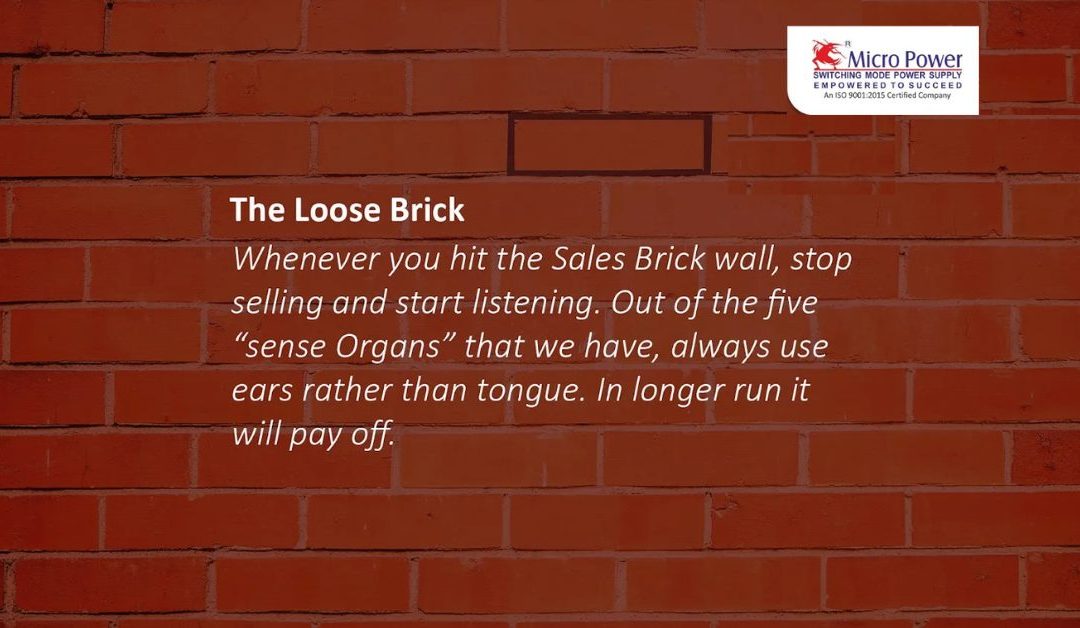I always hear sales people say that speaking to a particular prospect was like “hitting a brick wall.” The prospect’s guard was up in full force. The prospect seemed to get bored or, worse yet, to become defensive or offensive every time the salesperson mentioned a product benefit or feature. It pains me to hear this, as I have known exactly what it feels like to be in such a position. The situation is also very delicate as the prospect has the potential for the entire range of products
Whenever I have encountered such a fortress or offensive, my instinct has been to conceive an equally attacking battle plan or retort the likes of which this very difficult and disturbed character/prospect has never seen!
No. No. No! Of course that is not the way to go. We should not be attacking anyone whom we want to call a customer, anytime.
Next time you hit a brick wall, never attack head-on. Never ever try that. I promise it is painful. Instead, look for the loose brick. The loose brick is always something which the client needs the most. The loose brick is the absolute top priority to the client, at that given time (But be prepared. It will change — frequently). In the same way they say it is one step that begins the journey of a thousand miles, it is by starting to chip away at that one loose brick that will lead to taking down a prospects or clients entire wall of defence.
Finding the loose brick requires active listening and calm questioning, not interrogating. Also remember, if you want your prospect to get down to the truth, you may need to expose a little of yourself first to establish a deeper trust. If you take such an approach to your next difficult conversation, you will successfully achieve two things.
Discover the real problem.
If you are actively looking for the loose brick, you just might find out what is really a thorn in your client’s side. Many times, it is not what you would expect. You’ve got to find what their internal problems are, and they sometimes (read: usually) are not what is on the surface of their business. In fact, they are rarely related to the products or services you are selling.
Sometimes it is listening to their fears or frustrations about their current job or boss and offering an understanding ear will certainly help him. It could be just asking what their personal aspirations are relative to this project and assuring them that they will be met.
I always advocate and advise my Sales team for building relationship with decision makers and team members around him. At the same time, it is important to build cases “Brick by Brick” and give sufficient time to the customer to gain confidence in our products and services. This approach is always a soft music to my ears. Identifying just one loose brick will help build the relationship and relationship for ever.
Avoid death by complex sale.
Complex sales are just that — complex, and we often just do not have the time to execute them. Some people go into a sales call with a very well laid out plan of what they want to sell. You know what happens then? The buyer very often is inclined to figure out that the proposal is not right or needs a change.
You will be much better served by going into a sales call with a path in mind than without one, sure. But you must also have the willingness to listen and react and find a way to place your value proposition in the context of their immediate (right-this-very-minute!) needs. Once you begin to listen, sales will no longer be a time to sell but to let your prospect tell you what he/she wants and you configuring your product or service around those needs.
Remember, if you get resistance, stop even thinking about selling. Think about listening and understanding what the person (not the “client” or “customer” at that point) really needs. Your first goal should not be to sell anyway. You need a foot in the door. You need to build a trusting relationship. You need to get a chance to prove that relationship. So first look for the loose brick. You can always upsell later.
In conclusion:
1. It is not only important to sell.
2. When you hit the “Brick Wall” look for the loose brick. Aggressive approach may back fire. The customer may not be interested in your Products and Services at that time.
3. Make use of ears instead of tongue. Show patience. Use all the resources at your disposal to address the issue(s).
4. Identify long term business opportunity. Build case slowly. It is important to build relationship “Brick by Brick.”
5. Do not expect “Magic Stick” to work every time. After a month or so call back. In all the probability you will get receptive customer.
By Ashok Kale /Nagpur / Dated 16th January 2025.


Recent Comments